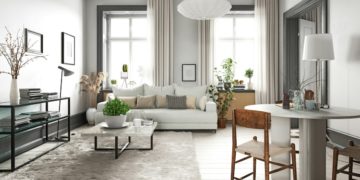Choosing the right flooring isn’t always easy. Every room serves a different purpose and has different conditions. High-traffic spaces need durable options, while cozy areas can focus more on comfort.
Moisture-prone rooms need water-resistant materials. Noise, temperature, and maintenance also matter. Think long-term before deciding. Keep your lifestyle and daily habits in mind.
Explore below to find the perfect flooring for each room.
Living Room
The living room sees a lot of activity, so flooring should be both durable and comfortable. Hardwood is a top pick because it adds warmth and value. If you want something softer underfoot, consider carpeting with a dense pile.
For a more modern touch, vinyl planks can give you the wood look without the cost. Think about pets and furniture too, as these can wear down certain materials.
A rug on top adds comfort and can define spaces. Noise absorption is helpful in open layouts. Look for options that are easy to clean. Neutral tones help keep the space flexible.
Choose flooring that supports both relaxation and social activity. Natural textures can make the room feel grounded and inviting.
Kitchen
The kitchen demands flooring that can handle spills, heat, and foot traffic. Tile is a popular option because it’s water-resistant and easy to wipe. Vinyl and laminate are also practical choices that resist moisture.
Avoid flooring that absorbs stains or is hard to clean. Consider slip resistance for safety. Some people like stone for its natural look, though it can be cold underfoot. Mats in high-use zones add comfort. Choose a style that complements your cabinets and counters.
Durability should come before looks, but you don’t have to sacrifice both. Always choose materials that can handle quick cleanups. Color can help hide minor spills and food stains.
Bedroom
Comfort is key in the bedroom, so soft flooring works well. Carpet creates a quiet, warm space and feels good when you wake up. Hardwood is another good choice for a clean look, especially when paired with area rugs.
Engineered wood flooring is a strong alternative with more stability. It holds up well to humidity and changes in temperature. Avoid materials that are too hard or cold, especially in the morning.
Color affects mood, so lighter tones can make the room feel calm. Dust control matters, especially for allergies. Keep maintenance low so cleaning doesn’t disrupt the space. Flooring should support a restful atmosphere. Focus on softness and warmth to enhance sleep quality.
Bathroom
Bathrooms need flooring that can handle water, humidity, and frequent cleaning. Ceramic or porcelain tile is ideal because it’s non-porous and lasts long. Vinyl sheet flooring is another option that offers fewer seams for water to seep through.
Avoid carpet or hardwood here, as they can warp or hold moisture. Some modern laminates are water-resistant, but check their warranty first. Heated floors are worth considering for comfort. Look for textured surfaces to avoid slipping.
Think about how often the room is used. Cleaning ease is crucial for hygiene. Use grout that resists mold and staining. Choose light tones to reflect light and open up the space.
Dining Room
The dining room needs flooring that balances style with function. Hardwood makes the space feel upscale and timeless. It can handle chairs and occasional spills if sealed well. Laminate gives a similar look with easier care.
Rugs can help define the area and protect the floor. Avoid high-pile carpet, which is hard to clean under a table. Choose materials that won’t scratch easily. Furniture pads help prevent dents.
Go for something you can sweep quickly. Consider stain resistance if meals are frequent. Floor finish should hold up to shifting chairs and foot traffic.
Home Office
A home office should feel calm, quiet, and focused. Carpet helps reduce noise, especially for upstairs rooms. Hardwood or laminate gives a professional look and is easy to maintain.
Consider vinyl for its versatility and soft feel under rolling chairs. Avoid flooring that causes echoes, which can be distracting. Add a rug for comfort and sound absorption. Think about foot traffic and furniture movement.
Easy cleanup is important if you eat or drink while working. Light tones brighten the space. Flooring should support long work sessions. Select options that improve acoustics for online meetings.
Basement
Basements are prone to moisture, so pick water-resistant flooring. Vinyl planks or tiles are a solid choice and can mimic wood or stone. Concrete with sealant is another option for a modern, industrial look.
Avoid solid hardwood, which can warp in humidity. Carpet tiles work well for warmth and easy replacement. Insulation under the floor can reduce cold. Watch for mold resistance when shopping.
Durability matters, especially for multipurpose use. A waterproof barrier layer is a smart add-on. Consider dehumidifiers to protect your floor. Choose finishes that handle temperature swings.
Hallways
Hallways see lots of traffic, so durability is key. Hardwood stands up to wear with proper finish. Laminate and vinyl are also good for resisting scuffs and dirt. Avoid carpet unless it’s low-pile and easy to clean.
Runners protect the floor and add style. Color should hide dust and marks well. Pick flooring that matches surrounding rooms for flow. Noise control is helpful in narrow areas. Easy cleaning helps with high footfall. Use matte finishes to reduce visible wear. Add trim or thresholds for a polished look.
Entryway
The entryway deals with dirt, moisture, and changing weather. Tile or stone holds up best and is simple to clean. Vinyl can also handle water and boots well. Avoid hardwood if the area isn’t sealed properly.
Mats can reduce wear and protect the surface. Choose a darker tone to mask dirt. Keep maintenance quick and easy. Durability should be top priority. Textured finishes prevent slipping.
Ensure drainage is good to prevent water pooling. Use flooring that can handle salt or mud.
Stairs
Stairs need traction and resilience. Hardwood with stair treads is a popular pick. Carpet helps reduce slipping and softens falls. Laminate works too but may be noisy. Avoid smooth surfaces without grip.
A runner can add safety and style. Match the stair flooring to adjoining rooms. Make sure edges are secure to prevent trips. Keep color consistent for better flow. Use non-slip strips if necessary. Check tread durability to avoid early wear.
Laundry Room
Moisture is constant in laundry rooms, so flooring must resist water. Tile and vinyl are both practical and easy to mop. Laminate may swell over time if water leaks. Avoid carpet or wood. Choose a floor with a smooth finish for quick cleanup.
Drainage and slope matter in case of spills. Think about vibration from the washer. Some rubber underlayment can absorb sound. Durable, water-tough options last longer. Select stain-resistant materials. Make sure flooring won’t shift under heavy machines.
Closets
Closets don’t need heavy-duty flooring, but continuity helps. Match the closet floor to the adjoining room. Carpet keeps it soft and quiet. Hardwood or laminate works if you want a clean, streamlined look.
Avoid slippery surfaces for walk-ins. Noise isn’t a big concern, but dust can be. Pick low-maintenance materials. Lighting impacts how flooring looks in small spaces.
A simple, cohesive look works best. Choose flooring that resists scuffs from shoes. Avoid textured floors that trap dust.
Sunroom
Sunrooms face strong sunlight and temperature shifts. Choose flooring that won’t fade or warp. Vinyl, tile, or sealed concrete hold up well. Avoid hardwood unless it’s engineered. Look for UV-resistant finishes.
Rugs add warmth without permanent change. Cooling underlayments help with heat. Pick a tone that reflects natural light. Durability matters due to outdoor shoes. Check expansion gaps for temperature changes. Use breathable materials if the room isn’t climate-controlled.
Garage
Garage flooring must handle weight, oil, and moisture. Sealed concrete is the top choice. Epoxy coatings help with stain resistance. Avoid wood or carpet. Vinyl tiles are an option if you want a finished look.
Durability is everything in this space. Easy cleaning is a plus. Choose a color that hides dirt. Look for slip resistance. Add protective mats under tires. Make sure the floor handles heavy tools and storage.
Kids’ Playroom
Kids need soft, safe flooring. Carpet tiles or rubber mats work well. Vinyl is also good for easy cleanup. Avoid hard flooring that can cause injury. Sound absorption is useful for loud play. Choose materials free from harmful chemicals.
Look for colorful, fun options. Maintenance should be easy for quick spills. Think of comfort, safety, and function. Pick flooring that supports active play. Select options that won’t be ruined by markers or spills.
Guest Room
A guest room should feel calm and neutral. Carpet gives a cozy, quiet feel. Hardwood with a rug offers comfort and elegance. Laminate is a good budget option. Avoid loud, cold materials.
Pick flooring that doesn’t require much upkeep. Soft colors help guests relax. Tie in the flooring with the room decor. Think long-term use and flexibility. Flooring should suit both short visits and longer stays. Go for a simple, welcoming design.
Mudroom
Mudrooms deal with dirt, wet shoes, and mess. Tile or vinyl is best for this space. Avoid carpet and hardwood. Look for waterproof, textured surfaces. Durability and ease of cleaning are key.
Add mats for extra protection. Keep tones dark to hide grime. Choose flooring that dries fast. Think function over form. Use floor trim or edging to stop water damage. Make sure the surface has good grip.
Pantry
Pantries need clean, easy-to-maintain flooring. Vinyl or laminate are smart choices. Tile is also a good pick. Avoid carpet or hardwood due to crumbs and spills. Non-slip surfaces help with safety. Match flooring to the kitchen for flow.
Choose neutral colors that don’t show dust. Keep it simple and practical. Low maintenance should guide your pick. Flooring should resist scratching from storage bins. Select finishes that won’t flake or chip.
Walk-in Closet
Walk-in closets feel better with warm, soft flooring. Carpet works well for comfort. Hardwood adds class but may echo. Laminate is fine if it matches the bedroom. Avoid flooring that’s too slippery.
Rugs can soften hard materials. Choose low-maintenance options. Think about lighting reflection. Make it consistent with nearby rooms. Quiet, clean, and cohesive is best. Choose surfaces that don’t snag clothing. Keep the floor clutter-resistant.
Nursery
Nurseries need gentle and safe flooring. Carpet offers comfort and warmth. Vinyl is easy to clean and resists stains. Avoid hard materials that can bruise. Look for non-toxic, hypoallergenic choices.
Soundproofing is useful during naps. Choose light, calming colors. Rugs can add a soft layer. Prioritize health and safety. Flooring should be soft for crawling. Avoid materials that hold allergens.
Home Gym
Home gyms need durable, shock-absorbing floors. Rubber mats are ideal for weight training. Vinyl works for lighter exercise. Avoid hardwood or carpet. Look for sweat resistance and grip.
Sound absorption is a bonus. Easy-to-clean surfaces matter. Match flooring to your workout type. Choose materials that protect your subfloor. Focus on strength and comfort. Make sure weights won’t crack or dent it.
Attic
Attics vary in use, so choose flooring based on function. For storage, plywood or basic laminate is enough. For living space, consider carpet or vinyl. Avoid heavy materials if weight is a concern. Insulation helps regulate temperature.
Soundproofing is a plus if it’s a bedroom. Choose flooring that’s easy to install. Keep it lightweight and practical. Make sure it’s easy to clean. Look for options that resist temperature swings. Pick materials that don’t require nails or glue.
Porch
Porches need flooring that handles weather. Tile, stone, or sealed concrete hold up outside. Avoid wood that isn’t treated for moisture. Vinyl is fine for enclosed spaces. Look for textured surfaces for grip.
Choose materials that won’t fade in sun. Match the home’s exterior for a cohesive look. Durability is a must. Think about drainage. Keep it simple and strong. Select finishes that resist mildew. Avoid flooring that becomes slick when wet.
Make Sure to Choose the Perfect Flooring for Each Room in Your Home
Choosing the perfect flooring for each room depends on how the space is used, the level of moisture, and your comfort needs. Every material has pros and cons, but matching them with room function makes the decision easier.
Focus on durability, maintenance, and look. Use rugs to adjust comfort without changing the base floor. Think long-term when investing in materials. Flooring impacts mood, function, and home value.
Keep it consistent across spaces where possible. Make choices that fit your lifestyle. Always aim for a balance of form and function.
Should you wish to read more, visit our blog page. We do have more!












































































